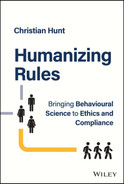USER MANUAL
Before we begin, here's a brief user manual for how to get the most out of the book.
How to Use This Book
Since the book is called Humanizing Rules, you'll be relieved to hear it isn't a set of rules to be slavishly followed. It contains six specific ones, but don't worry; they're not traditional rules. Like the rest of this book, think of them as you would a travel guide or cookbook. I want to inspire you rather than provide you with an instruction manual to be followed to the letter. Humanizing Rules is written with a general audience in mind which should mean that the majority of dynamics I highlight and ideas I suggest are relevant to your situation. But, occasionally, they might not be. If that happens, feel free to adapt the rules to meet your needs, just as you would a travel itinerary or recipe.
Humanizing Rules isn't an academic book that presents the findings of rigorous academic research that has been tested and peer‐reviewed. None of the ideas suggested in the book has been tested in laboratory conditions. Most have, however, been tested in the real world, while others are still work in progress. In sharing these, I want to suggest new ideas you might not have previously considered. My hope in doing so is to inspire you to think differently about how you go about things.
Some ideas I propose in the book are counter‐intuitive and challenge traditional orthodoxy. There would be little point in writing it if I wasn't going to do that! Sometimes, I will point you towards things that might be challenging to implement, particularly if you are operating in a harsh regulatory environment. My advice is to do what you can. But don't let that be an excuse for not trying new things. Small changes in the right direction are better than no changes. Most importantly, do have fun!
Terminology
As we try to humanize rules, there is a wide range of applications for the ideas I explore. For example, a technique that can help a team leader make it more likely their team will meet a requirement to fill in timesheets can also be used elsewhere. It can help Human Resources departments to encourage managers to attend a training course or by Compliance to get employees to complete a regulatory return.
I have used standard terms throughout the book to avoid confusion and repetition and deliver consistency and simplicity. To avoid misunderstandings, here are the terms I frequently use and an explanation of what they mean:
- Employees are the people in your organisation, the primary “target audience” we seek to influence. However, we can also use the same techniques and ideas to persuade other target audiences in entirely different contexts. For example, your customers, suppliers, regulators, investors, or people applying for jobs in your organisation.
- Rules are what you want or need your employees to do or not do. What we might call your “desired outcome”. The most obvious example of a desired outcome is compliance with the rules you have within your organisation. To avoid being repetitious – and because sometimes I need a different word – I occasionally use “Requirement” instead of “Rule”, for example, when I'm referring to the desired outcome of having your employees comply with externally imposed laws or regulations. Rules or Regulations might also mean following instructions, policies, codes, orders, mandates, or any other instrument or tool used to influence the behaviour of employees. That includes responding in the desired manner to email messages and poster campaigns.
- Compliance means the act of complying with something. In other words, doing “what we want them to do” or “what we need them to do”. It also captures concepts such as adherence. It is not the same as “big C” Compliance, which I use to refer to the function within an organisation responsible for ensuring compliance with regulations; though, if compliance comes at the start of a sentence, then I will capitalise it! Finally, for the avoidance of doubt, the term noncompliance means the opposite of compliance.
- Framework means the architecture you're using to influence your employees. The most obvious example is a compliance framework, but it can also mean any rules, programmes or systems you're using to deliver your desired outcomes, such as a communications campaign, for example.
- Asking your employees to do something means the act of communicating your desired outcome to them. You may prefer to think of it as “telling them what to do”, “reminding them of the rules”, “giving orders”, or “issuing warnings”. The verb “ask” isn't intended to suggest that you have no authority over your employees. I use it not only because it is polite but also as a reminder that, often, we need to work with, rather than against, our employees to achieve our desired outcome.
